Separating Biomass Gains and Losses of Planted Forest and Natural Forest and Their Contributions to Forest Biomass Carbon Storage in China for 2005–2020
Abstract
1. Introduction
2. Materials and Methods
2.1. Above- and Below-Ground Forest Biomass in China for 2005–2020
2.2. Natural and Planted Forest Maps in China
2.3. Forest Inventory Data
2.4. Above-Ground Forest Biomass Product for 2010
2.5. Data Processing
2.6. Methods
3. Results
3.1. Distribution of Mean Planted and Natural Forest Biomass for 2005–2020
3.2. Interannual Changes in Forest Biomass, Above-Ground Biomass, and Below-Ground Biomass for Planted and Natural Forest Between 2005 and 2020
3.3. Interannual Changes in Forest Area for Planted and Natural Forest Between 2005 and 2020
3.4. Latitudinal Changes in Biomass and Area for Forest, Natural Forest, and Planted Forest in 2005 and 2020
3.5. Changes in Area and Biomass for Two Groups of Planted Forest from 2005 to 2020
3.6. Changes in Biomass Gains and Losses in 2010, 2015, and 2020 Compared with Biomass in 2005
3.7. Evaluation of Estimated Forest Biomass in 2015 with Inventory-Based Forest Biomass
3.8. Evaluation of Estimated Forest Above-Ground Biomass in 2010 with Other Products
4. Discussion
4.1. Comparison to Previous Methods
4.2. Comparison to Previous Results
4.3. Limitations and Future Study
5. Conclusions
Author Contributions
Funding
Data Availability Statement
Conflicts of Interest
References
- Lan, X.; Tans, P.; Thoning, K.W. Trends in Globally-Averaged CO2 Determined from NOAA Global Monitoring Laboratory Measurements; Global Monitoring Laboratory: Boulder, CO, USA, 2024. [CrossRef]
- Friedlingstein, P.; O’Sullivan, M.; Jones, M.W.; Andrew, R.M.; Bakker, D.C.E.; Hauck, J.; Landschützer, P.; Le Quéré, C.; Luijkx, I.T.; Peters, G.P.; et al. Global Carbon Budget 2023. Earth Syst. Sci. Data 2023, 15, 5301–5369. [Google Scholar] [CrossRef]
- Tian, H.; Lu, C.; Ciais, P.; Michalak, A.M.; Canadell, J.G.; Saikawa, E.; Huntzinger, D.N.; Gurney, K.R.; Sitch, S.; Zhang, B.; et al. The terrestrial biosphere as a net source of greenhouse gases to the atmosphere. Nature 2016, 531, 225–228. [Google Scholar] [CrossRef] [PubMed]
- Monteiro, J.M. The year 2023 may afford us a peek at a warmer world. Commun. Earth Environ. 2024, 5, 280. [Google Scholar] [CrossRef]
- Peters, G.P.; Andrew, R.M.; Boden, T.; Canadell, J.G.; Ciais, P.; Le Quéré, C.; Marland, G.; Raupach, M.R.; Wilson, C. The challenge to keep global warming below 2 °C. Nat. Clim. Change 2013, 3, 4–6. [Google Scholar] [CrossRef]
- Pan, Y.; Birdsey, R.A.; Phillips, O.L.; Houghton, R.A.; Fang, J.; Kauppi, P.E.; Keith, H.; Kurz, W.A.; Ito, A.; Lewis, S.L.; et al. The enduring world forest carbon sink. Nature 2024, 631, 563–569. [Google Scholar] [CrossRef] [PubMed]
- Xu, H.; Yue, C.; Zhang, Y.; Liu, D.; Piao, S. Forestation at the right time with the right species can generate persistent carbon benefits in China. Proc. Natl. Acad. Sci. USA 2023, 120, e2304988120. [Google Scholar] [CrossRef]
- Piao, S.; Wang, X.; Park, T.; Chen, C.; Lian, X.; He, Y.; Bjerke, J.W.; Chen, A.; Ciais, P.; Tømmervik, H.; et al. Characteristics, drivers and feedbacks of global greening. Nat. Rev. Earth Environ. 2020, 1, 14–27. [Google Scholar] [CrossRef]
- Lu, F.; Hu, H.; Sun, W.; Zhu, J.; Liu, G.; Zhou, W.; Zhang, Q.; Shi, P.; Liu, X.; Wu, X.; et al. Effects of national ecological restoration projects on carbon sequestration in China from 2001 to 2010. Proc. Natl. Acad. Sci. USA 2018, 115, 4039–4044. [Google Scholar] [CrossRef]
- Zeng, W.; Chen, X.; Yang, X. Estimating changes of forest carbon storage in China for 70 years (1949–2018). Sci. Rep. 2023, 13, 16864. [Google Scholar] [CrossRef]
- Yu, Z.; Liu, S.; Li, H.; Liang, J.; Liu, W.; Piao, S.; Tian, H.; Zhou, G.; Lu, C.; You, W.; et al. Maximizing carbon sequestration potential in Chinese forests through optimal management. Nat. Commun. 2024, 15, 3154. [Google Scholar] [CrossRef]
- Tong, X.; Brandt, M.; Yue, Y.; Ciais, P.; Rudbeck Jepsen, M.; Penuelas, J.; Wigneron, J.-P.; Xiao, X.; Song, X.-P.; Horion, S.; et al. Forest management in southern China generates short term extensive carbon sequestration. Nat. Commun. 2020, 11, 129. [Google Scholar] [CrossRef] [PubMed]
- Busch, J.; Bukoski, J.J.; Cook-Patton, S.C.; Griscom, B.; Kaczan, D.; Potts, M.D.; Yi, Y.; Vincent, J.R. Cost-effectiveness of natural forest regeneration and plantations for climate mitigation. Nat. Clim. Change 2024, 14, 996–1002. [Google Scholar] [CrossRef]
- Fan, Z.; Sun, J.; Tagesson, T.; Wang, L.; Xu, S.; Tan, W.; Tian, F.; Ye, W.; Tan, Q.; Wang, S.; et al. Planted Forests Greened 7% Slower Than Natural Forests in Southern China Over the Past Forty Years. Geophys. Res. Lett. 2024, 51, e2024GL111209. [Google Scholar] [CrossRef]
- Yu, Z.; Ciais, P.; Piao, S.; Houghton, R.A.; Lu, C.; Tian, H.; Agathokleous, E.; Kattel, G.R.; Sitch, S.; Goll, D.; et al. Forest expansion dominates China’s land carbon sink since 1980. Nat. Commun. 2022, 13, 5374. [Google Scholar] [CrossRef]
- Cheng, K.; Yang, H.; Guan, H.; Ren, Y.; Chen, Y.; Chen, M.; Yang, Z.; Lin, D.; Liu, W.; Xu, J.; et al. Unveiling China’s natural and planted forest spatial–temporal dynamics from 1990 to 2020. ISPRS J. Photogramm. Remote Sens. 2024, 209, 37–50. [Google Scholar] [CrossRef]
- Cheng, K.; Yang, H.; Tao, S.; Su, Y.; Guan, H.; Ren, Y.; Hu, T.; Li, W.; Xu, G.; Chen, M.; et al. Carbon storage through China’s planted forest expansion. Nat. Commun. 2024, 15, 4106. [Google Scholar] [CrossRef] [PubMed]
- Sánchez-García, C.; Revelles, J.; Burjachs, F.; Euba, I.; Expósito, I.; Ibáñez, J.; Schulte, L.; de Pablo, J.F.-L. What burned the forest? Wildfires, climate change and human activity in the Mesolithic—Neolithic transition in SE Iberian Peninsula. Catena 2024, 234, 107542. [Google Scholar] [CrossRef]
- Saatchi, S.S.; Harris, N.L.; Brown, S.; Lefsky, M.; Mitchard, E.T.A.; Salas, W.; Zutta, B.R.; Buermann, W.; Lewis, S.L.; Hagen, S.; et al. Benchmark map of forest carbon stocks in tropical regions across three continents. Proc. Natl. Acad. Sci. USA 2011, 108, 9899–9904. [Google Scholar] [CrossRef]
- Nie, S.; Wang, C.; Zeng, H.; Xi, X.; Li, G. Above-ground biomass estimation using airborne discrete-return and full-waveform LiDAR data in a coniferous forest. Ecol. Indic. 2017, 78, 221–228. [Google Scholar] [CrossRef]
- Chen, Y.; Feng, X.; Fu, B.; Ma, H.; Zohner, C.M.; Crowther, T.W.; Huang, Y.; Wu, X.; Wei, F. Maps with 1 km resolution reveal increases in above- and belowground forest biomass carbon pools in China over the past 20 years. Earth Syst. Sci. Data 2023, 15, 897–910. [Google Scholar] [CrossRef]
- Stovall, A.E.L.; Shugart, H.H. Improved Biomass Calibration and Validation With Terrestrial LiDAR: Implications for Future LiDAR and SAR Missions. IEEE J. Sel. Top. Appl. Earth Obs. Remote Sens. 2018, 11, 3527–3537. [Google Scholar] [CrossRef]
- de Faria, L.D.; Matricardi, E.A.T.; Marimon, B.S.; Miguel, E.P.; Junior, B.H.M.; de Oliveira, E.A.; Prestes, N.C.C.d.S.; de Carvalho, O.L.F. Biomass Prediction Using Sentinel-2 Imagery and an Artificial Neural Network in the Amazon/Cerrado Transition Region. Forests 2024, 15, 1599. [Google Scholar] [CrossRef]
- Cheng, K.; Su, Y.; Guan, H.; Tao, S.; Ren, Y.; Hu, T.; Ma, K.; Tang, Y.; Guo, Q. Mapping China’s planted forests using high resolution imagery and massive amounts of crowdsourced samples. ISPRS J. Photogramm. Remote Sens. 2023, 196, 356–371. [Google Scholar] [CrossRef]
- Li, W.; MacBean, N.; Ciais, P.; Defourny, P.; Lamarche, C.; Bontemps, S.; Houghton, R.A.; Peng, S. Gross and net land cover changes in the main plant functional types derived from the annual ESA CCI land cover maps (1992–2015). Earth Syst. Sci. Data 2018, 10, 219–234. [Google Scholar] [CrossRef]
- Besnard, S.; Koirala, S.; Santoro, M.; Weber, U.; Nelson, J.; Gütter, J.; Herault, B.; Kassi, J.; N’Guessan, A.; Neigh, C.; et al. Mapping global forest age from forest inventories, biomass and climate data. Earth Syst. Sci. Data 2021, 13, 4881–4896. [Google Scholar] [CrossRef]
- Fick, S.E.; Hijmans, R.J. WorldClim 2: New 1-km spatial resolution climate surfaces for global land areas. Int. J. Climatol. 2017, 37, 4302–4315. [Google Scholar] [CrossRef]
- National Forestry and Grassland Administration. China Forest Resource Report (2014–2018); China forestry publishing house: Beijing, China, 2019. [Google Scholar]
- Santoro, M.; Cartus, O.; Carvalhais, N.; Rozendaal, D.M.A.; Avitabile, V.; Araza, A.; de Bruin, S.; Herold, M.; Quegan, S.; Rodríguez-Veiga, P.; et al. The global forest above-ground biomass pool for 2010 estimated from high-resolution satellite observations. Earth Syst. Sci. Data 2021, 13, 3927–3950. [Google Scholar] [CrossRef]
- Fang, J.; Yu, G.; Liu, L.; Hu, S.; Chapin, F.S. Climate change, human impacts, and carbon sequestration in China. Proc. Natl. Acad. Sci. USA 2018, 115, 4015–4020. [Google Scholar] [CrossRef]
- National Forestry and Grassland Administration. China Forest Resource Report (2009–2013); China forestry publishing house: Beijing, China, 2014. [Google Scholar]
- Xu, H.; He, B.; Guo, L.; Yan, X.; Zeng, Y.; Yuan, W.; Zhong, Z.; Tang, R.; Yang, Y.; Liu, H.; et al. Global Forest Plantations Mapping and Biomass Carbon Estimation. J. Geophys. Res. Biogeosci. 2024, 129, e2023JG007441. [Google Scholar] [CrossRef]
- Tang, X.; Zhao, X.; Bai, Y.; Tang, Z.; Wang, W.; Zhao, Y.; Wan, H.; Xie, Z.; Shi, X.; Wu, B.; et al. Carbon pools in China’s terrestrial ecosystems: New estimates based on an intensive field survey. Proc. Natl. Acad. Sci. USA 2018, 115, 4021–4026. [Google Scholar] [CrossRef]
- Ma, L.; Ma, J.; Yan, P.; Tian, F.; Peñuelas, J.; Rao, M.P.; Fu, Y.; Hu, Z. Planted Forests in China Have Higher Drought Risk Than Natural Forests. Glob. Change Biol. 2025, 31, e70055. [Google Scholar] [CrossRef] [PubMed]
- Abbasi, A.O.; Tang, X.; Harris, N.L.; Goldman, E.D.; Gamarra, J.G.P.; Herold, M.; Kim, H.S.; Luo, W.; Silva, C.A.; Tchebakova, N.M.; et al. Spatial database of planted forests in East Asia. Sci. Data 2023, 10, 480. [Google Scholar] [CrossRef] [PubMed]
- Shanley, C.S.; Graves, R.A.; Drever, C.R.; Schindel, M.; Robertson, J.C.; Case, M.J.; Biswas, T. Mapping forest-based natural climate solutions. Commun. Earth Environ. 2024, 5, 502. [Google Scholar] [CrossRef]
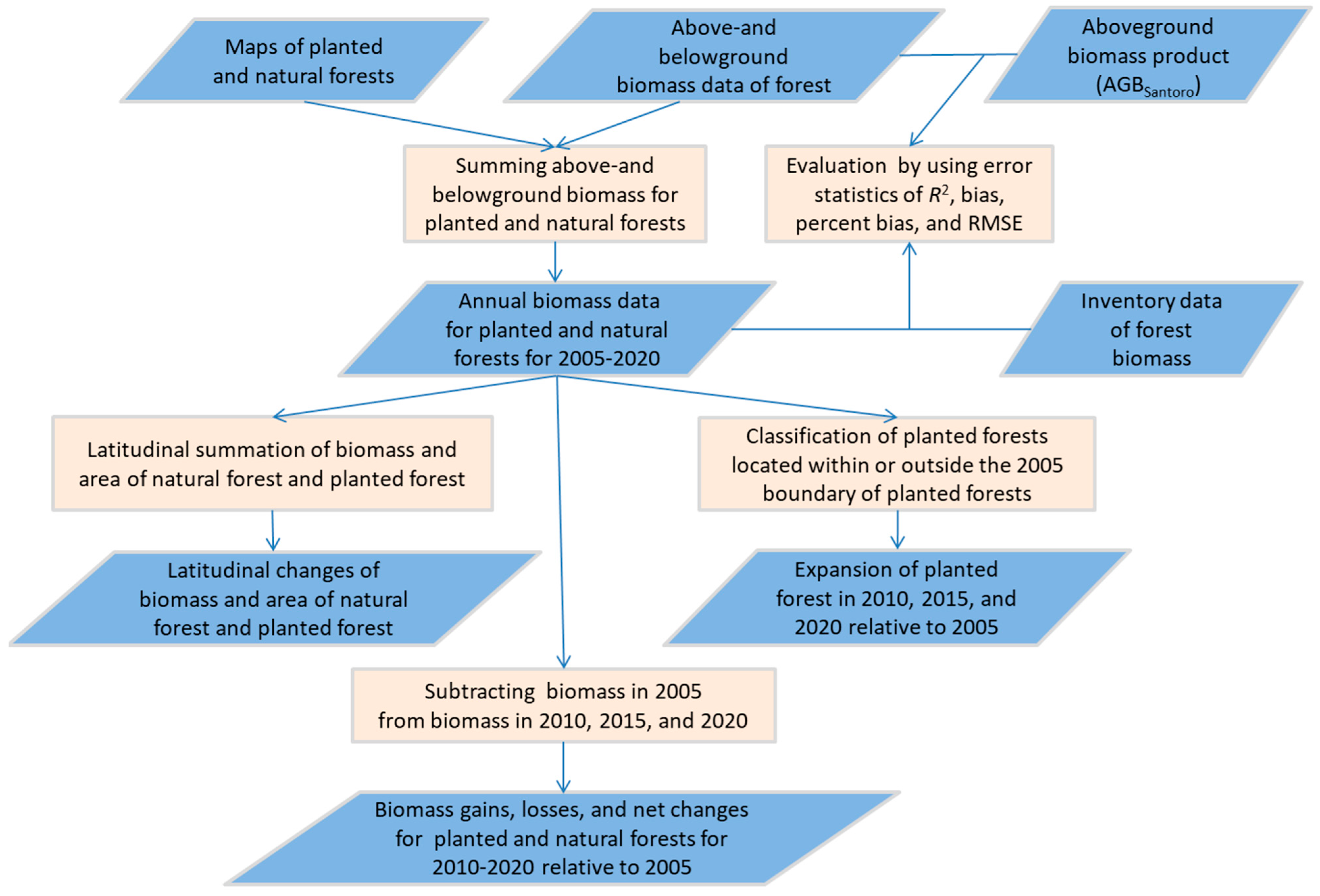

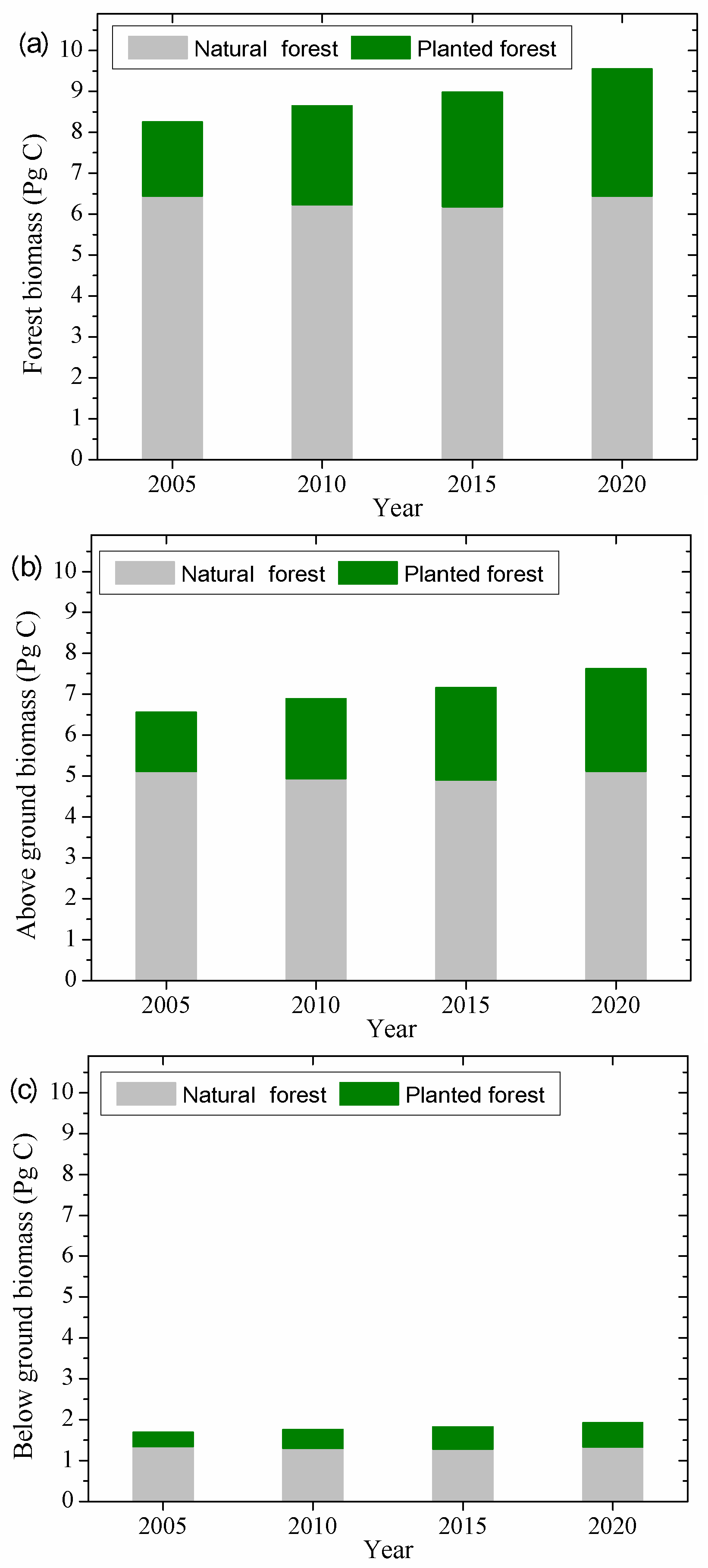
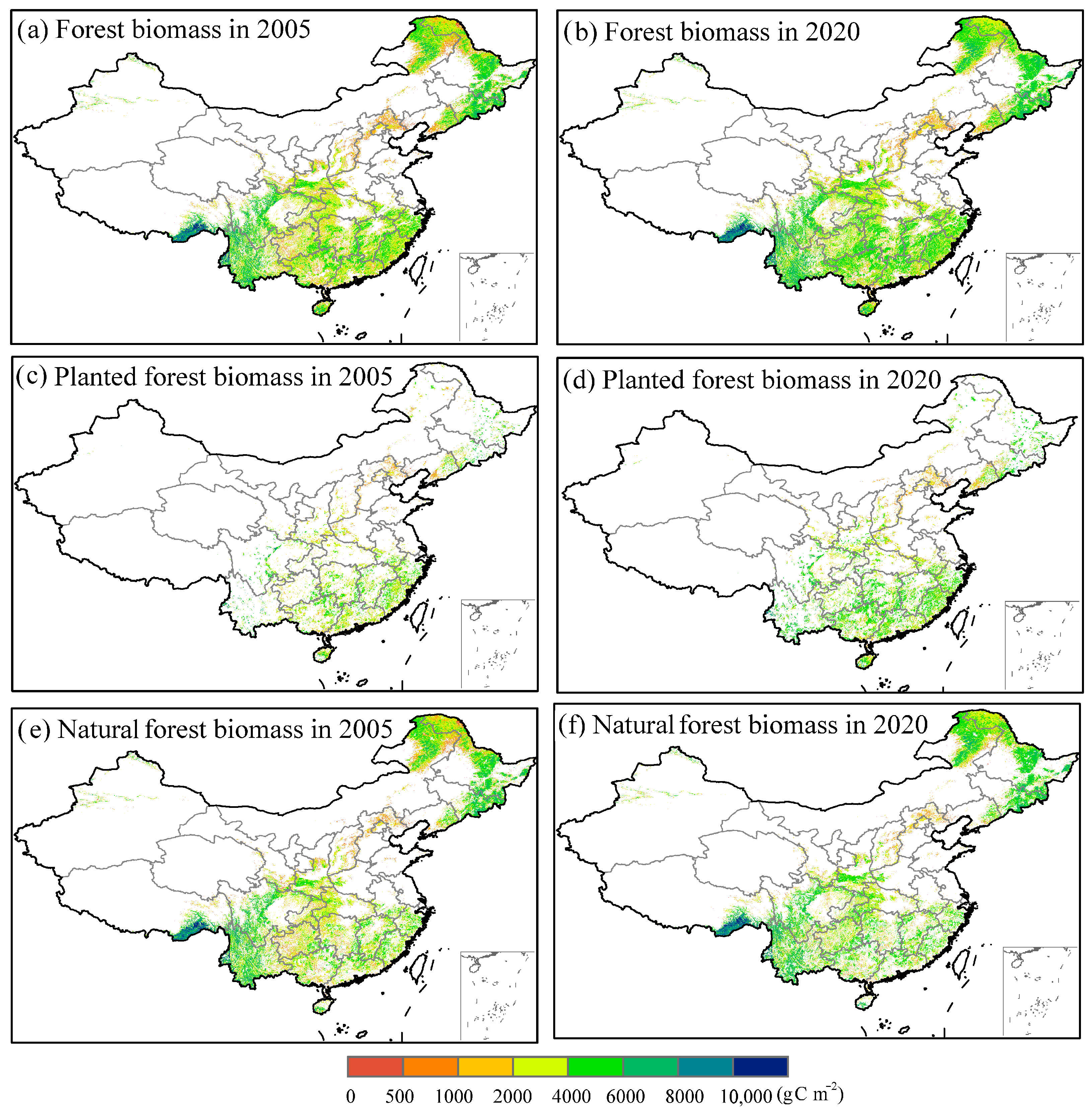

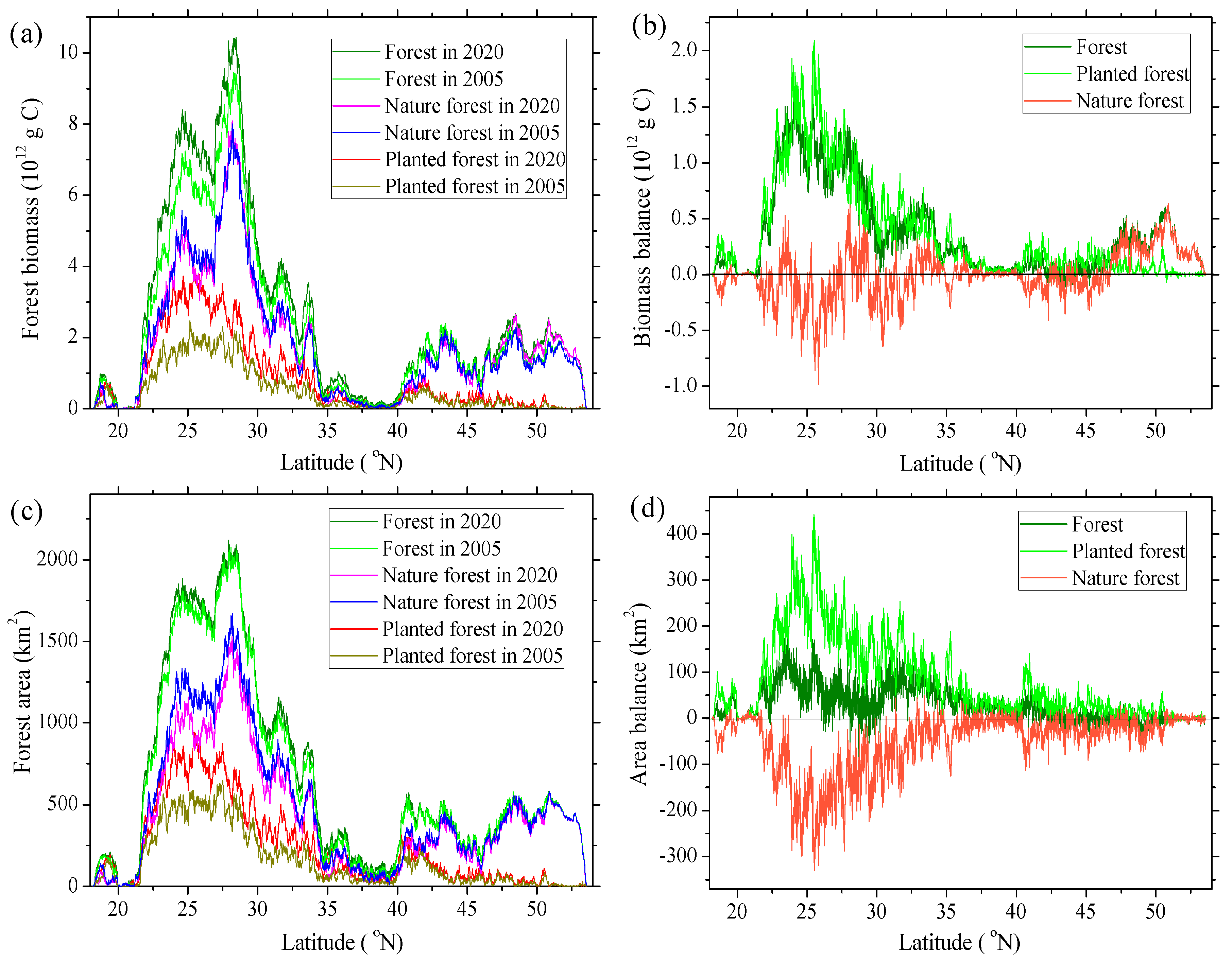

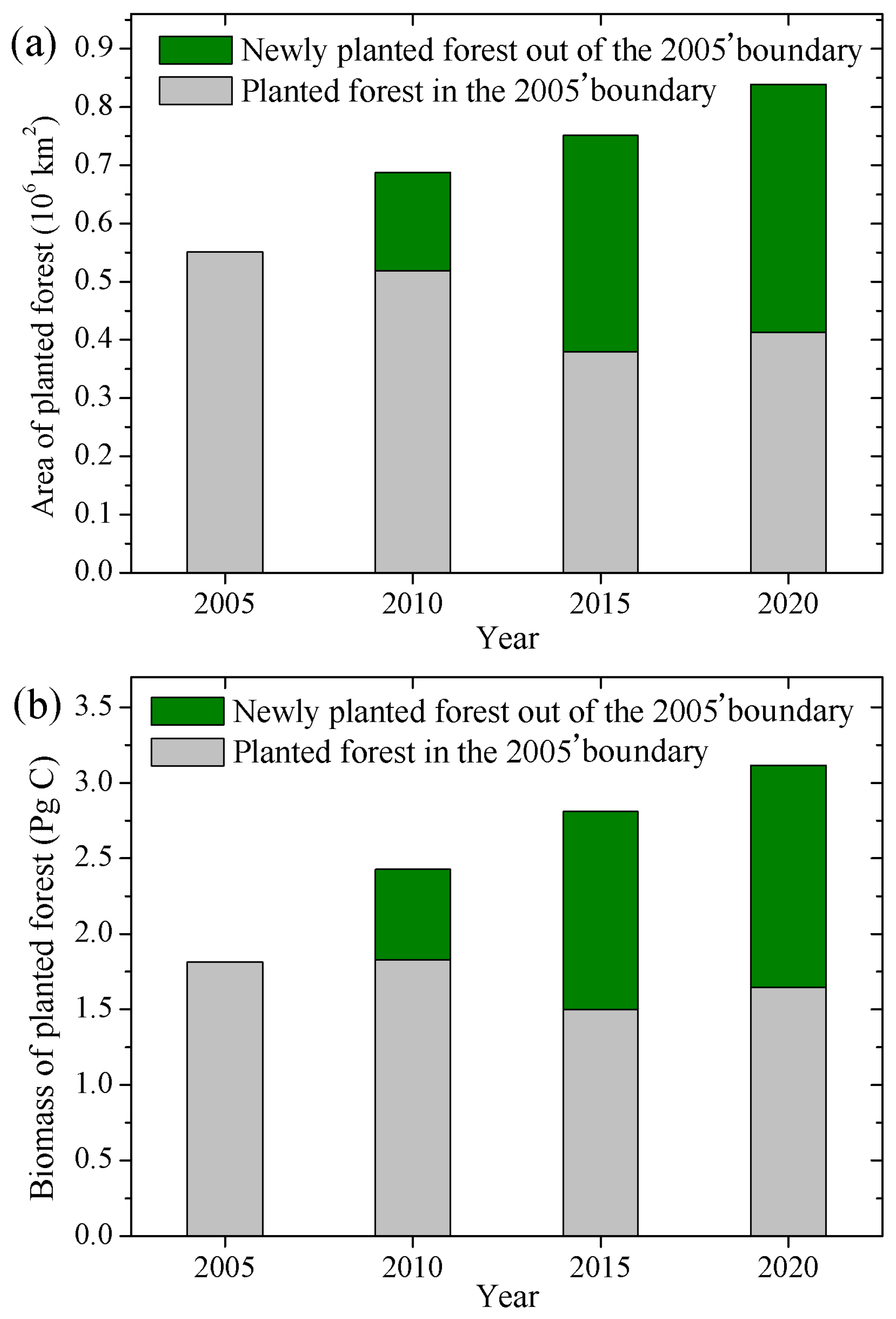

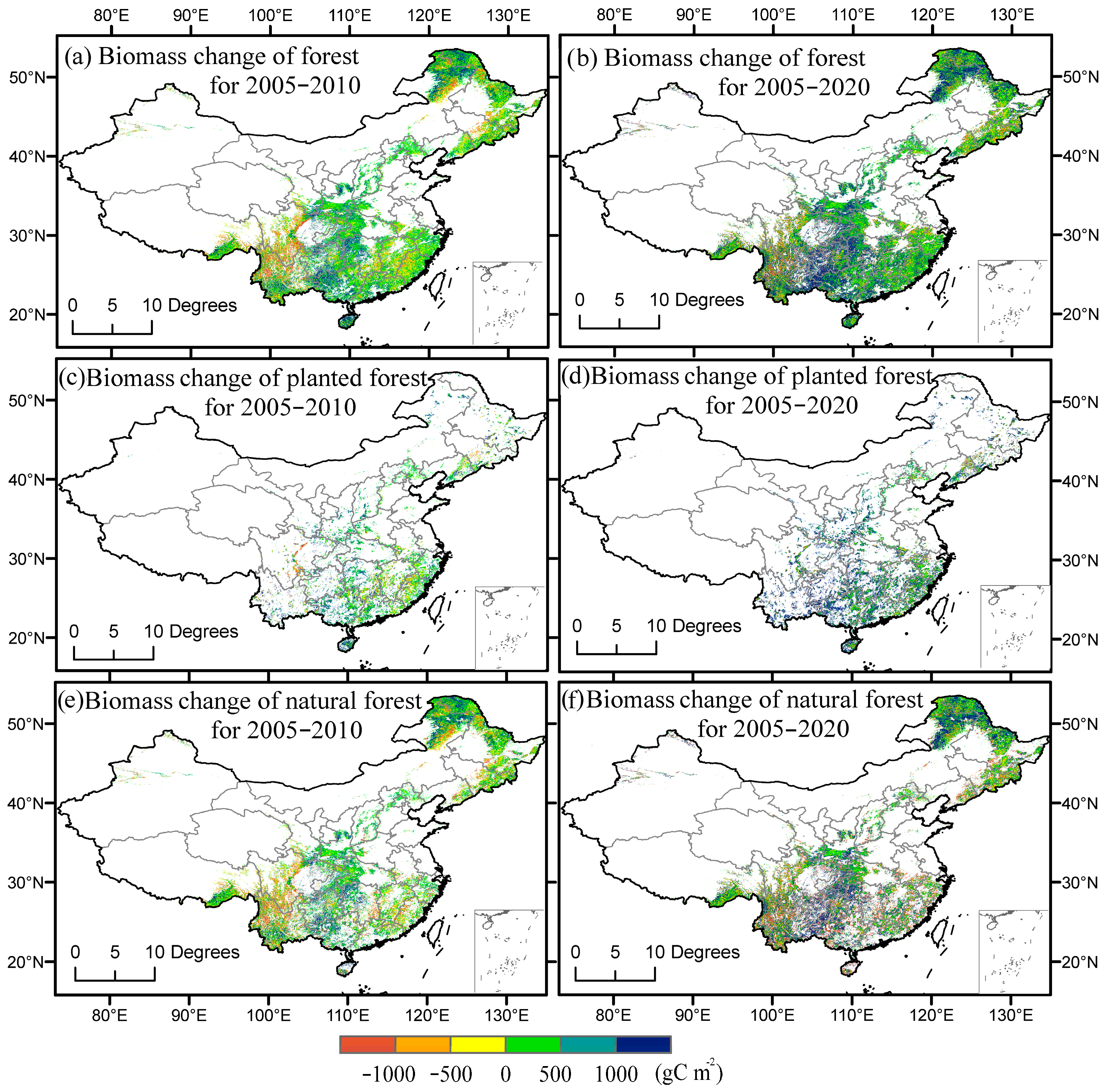
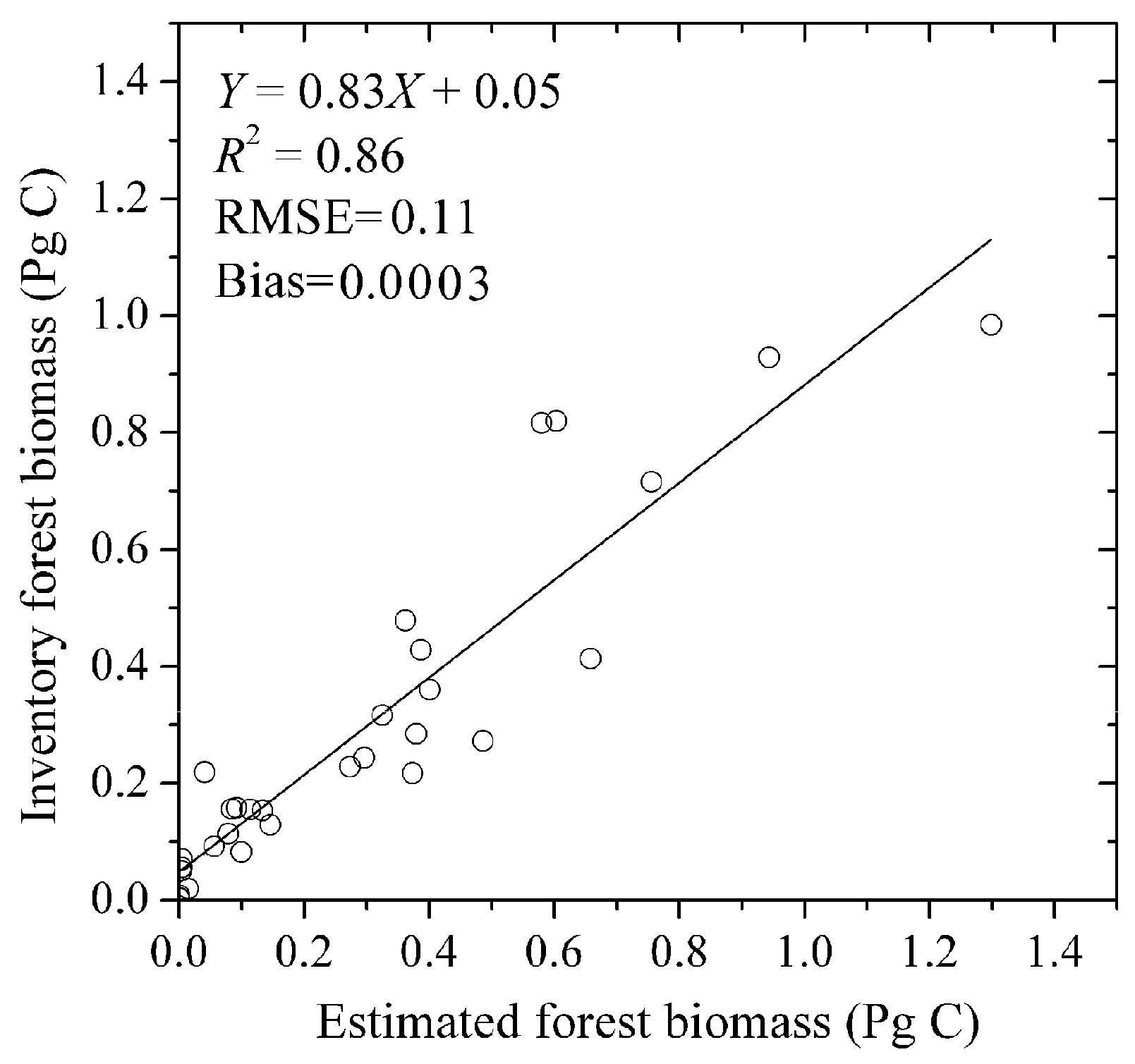

| Region | Planted Forest Biomass and Percentage | Natural Forest Biomass and Percentage | Total Forest Biomass and Percentage |
|---|---|---|---|
| South | 2.19 Pg C (86.2%) | 4.44 Pg C (70.3%) | 6.63 Pg C (74.9%) |
| North | 0.35 Pg C (13.8%) | 1.88 Pg C (29.7%) | 2.23 Pg C (25.1%) |
| All | 2.54 Pg C (100%) | 6.32 Pg C (100%) | 8.86 Pg C (100%) |
| Year | Planted Forest (Pg C) | Natural Forest (Pg C) | Total Biomass (Pg C) |
|---|---|---|---|
| 2005 | 1.81 | 6.44 | 8.26 |
| 2010 | 2.43 | 6.23 | 8.65 |
| 2015 | 2.81 | 6.18 | 8.99 |
| 2020 | 3.11 | 6.44 | 9.56 |
Disclaimer/Publisher’s Note: The statements, opinions and data contained in all publications are solely those of the individual author(s) and contributor(s) and not of MDPI and/or the editor(s). MDPI and/or the editor(s) disclaim responsibility for any injury to people or property resulting from any ideas, methods, instructions or products referred to in the content. |
© 2025 by the authors. Licensee MDPI, Basel, Switzerland. This article is an open access article distributed under the terms and conditions of the Creative Commons Attribution (CC BY) license (https://creativecommons.org/licenses/by/4.0/).
Share and Cite
Yan, H.; Mo, J.; Cao, Y.; Zhao, J.; Shugart, H.H. Separating Biomass Gains and Losses of Planted Forest and Natural Forest and Their Contributions to Forest Biomass Carbon Storage in China for 2005–2020. Forests 2025, 16, 884. https://doi.org/10.3390/f16060884
Yan H, Mo J, Cao Y, Zhao J, Shugart HH. Separating Biomass Gains and Losses of Planted Forest and Natural Forest and Their Contributions to Forest Biomass Carbon Storage in China for 2005–2020. Forests. 2025; 16(6):884. https://doi.org/10.3390/f16060884
Chicago/Turabian StyleYan, Hao, Jianfei Mo, Yun Cao, Junfang Zhao, and Herman H. Shugart. 2025. "Separating Biomass Gains and Losses of Planted Forest and Natural Forest and Their Contributions to Forest Biomass Carbon Storage in China for 2005–2020" Forests 16, no. 6: 884. https://doi.org/10.3390/f16060884
APA StyleYan, H., Mo, J., Cao, Y., Zhao, J., & Shugart, H. H. (2025). Separating Biomass Gains and Losses of Planted Forest and Natural Forest and Their Contributions to Forest Biomass Carbon Storage in China for 2005–2020. Forests, 16(6), 884. https://doi.org/10.3390/f16060884






